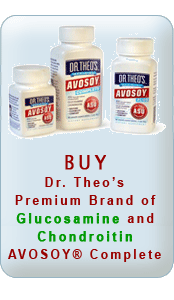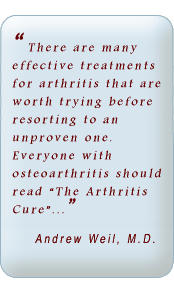Medical Evidence
Glucosamine and Chondroitin Sulfate
Regulate Gene Expression and Synthesis of Nitric Oxide and Prostaglandin
E(2) in Articular Cartilage Explants. Chan PS, Caron
JP, Rosa GJ, Orth MW. Department of Animal Science, Michigan State
University, East Lansing, MI 48824, USA.
Objective: Glucosamine (GLN)
and chondroitin sulfate (CS) are widely used to alleviate symptoms
of osteoarthritis (OA). However, the mechanism(s) of action of
these nutraceuticals remains unresolved. In the present study,
we determined the effect of physiologically relevant concentrations
of GLN and CS on gene expression and synthesis of nitric oxide
(NO) and prostaglandin E(2) (PGE(2)) in cytokine-stimulated articular
cartilage explants. METHODS: Using bovine articular cartilage
explants in culture stimulated with IL-1, the effects of physiologically
relevant concentrations of GLN and CS on gene expression of inducible
nitric oxide synthase (iNOS), endothelial nitric oxide synthase
(eNOS), cyclooxygenase-2 (COX-2) and microsomal prostaglandin
E synthase-1 (mPGEs1) were assessed with quantitative real-time
polymerase chain reaction (Q-RT-PCR). The production of NO and
PGE(2) was also quantified. RESULTS: CS and the GLN and CS combination
at concentrations attainable in the blood down-regulated IL-1
induced mRNA expression of iNOS at 24 and 48 h post-culture. Up-regulated
iNOS expression at 24h by IL-1 was also suppressed by GLN. GLN
and CS transiently repressed the cytokine-stimulated mPGEs1 transcript.
Synthesis of NO was reduced with CS alone and the combination
after 24h of culture. Repression of COX-2 transcripts by GLN and
CS was accompanied by concomitant reduction in PGE(2). CONCLUSION:
Our results indicate that physiologically relevant concentrations
of GLN and CS can regulate gene expression and synthesis of NO
and PGE(2), providing a plausible explanation for their purported
anti-inflammatory properties.
Source: Osteoarthritis Cartilage.
2005 May;13(5):387-94.
Dr. Theo's Comments: This
is an important study that shows several things: first of all,
the supplements have a well-defined mechanism of action at the
concentrations one would expect by oral (not topical) dosing.
Second, rather than just block enzymes (the major action of pain
relievers), these supplements actually beneficially alter the
gene expression (production) of harmful elements in osteoarthritic
cartilage. Third, a mechanism for anti-inflammatory and pain relieving
effect is noted. Finally, the combination of all of these actions
is exactly what one would want for treating osteoarthrits, except
for the fact that the supplements might take a weeks to months
to reach full effect.




